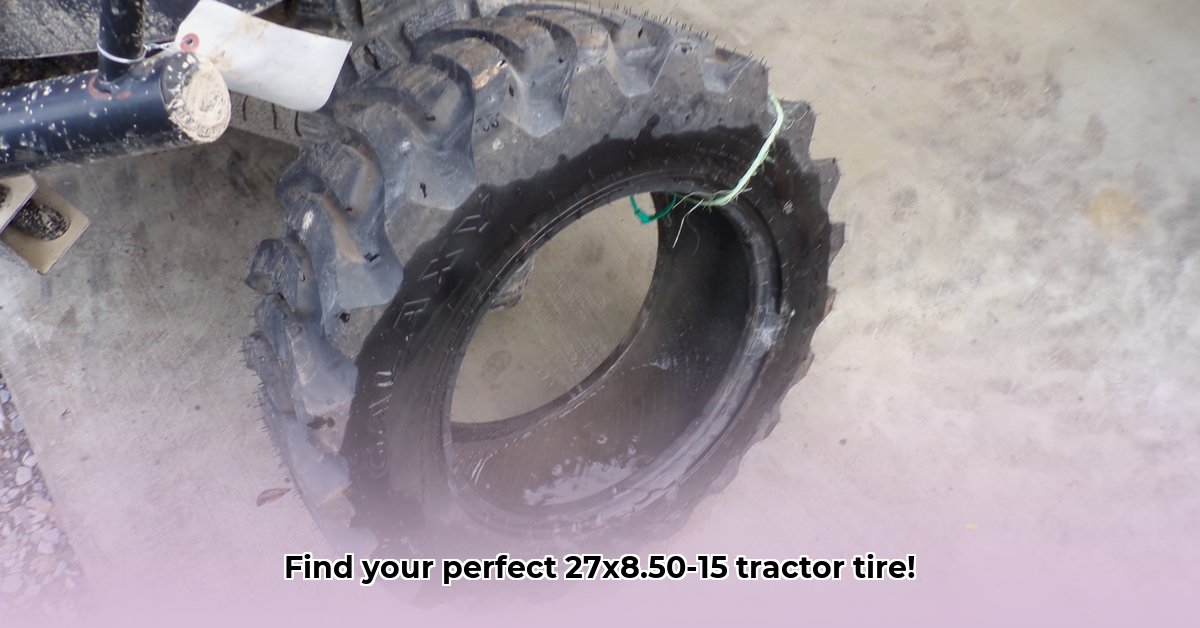
Choosing the right tires for your compact tractor or small agricultural equipment is crucial for optimal performance, longevity, and safety. This comprehensive guide focuses on the 27x8.50-15 tire size, breaking down the key factors to consider and providing actionable advice to help you make an informed decision. We'll explore load capacity, terrain suitability, speed ratings, tire construction, and more, culminating in recommendations and troubleshooting tips. For even more detailed information, check out this comprehensive guide.
Key Considerations for Choosing Your 27x8.50-15 Tractor Tire
Before you begin shopping, several crucial factors will determine the best tire for your needs. Ignoring these can lead to premature wear, reduced performance, and even safety hazards.
Load Capacity: Matching Tire Strength to Your Tractor's Weight
The load capacity, expressed in pounds, indicates the maximum weight a tire can safely support. This isn't just the weight of your tractor; consider the weight of any implements, cargo, or towed equipment. Exceeding the load capacity significantly increases the risk of tire failure. Always consult your tractor's owner's manual for the recommended load capacity for each tire position. Underestimating this is a common mistake that can lead to costly repairs. Isn't the safety of your operation worth the time spent on this detail?
Terrain: Selecting the Right Tread Pattern for Optimal Traction
The type of terrain you operate on greatly influences the ideal tread pattern. Deep lug R-1W patterns (think aggressive treads) provide exceptional traction in mud and soft soil, while R-1 patterns (slightly less aggressive) offer a balance between traction and wear on drier surfaces. Operating on primarily paved surfaces? A tire with a smoother tread will extend its lifespan and provide a more comfortable ride. How does your typical workload influence the pattern you should select?
Speed Rating: Understanding the Limits for Safe Operation
Every tire has a maximum safe speed. Operating above this speed – even slightly – dramatically increases the risk of a blowout. Prioritize safety and always adhere to the manufacturer's specified speed rating. This is critical for both your safety and the longevity of the tire. Do you frequently exceed 20 mph while operating your tractor? If so, the speed rating is a critical selection criterion.
Tire Construction: Bias-Ply vs. Radial – A Comparison
Two main tire constructions exist: radial and bias-ply. Radial tires generally provide better fuel efficiency and a smoother ride. However, bias-ply tires often demonstrate superior durability in rough terrains, hence their popularity with contractors. The choice depends on your priorities: fuel efficiency versus ruggedness. What are your primary operational priorities: fuel efficiency or extreme durability? Consider the trade-off between initial cost and long-term savings with each.
Price and Availability: Finding a Balance Between Quality and Cost
Prices for 27x8.50-15 tractor tires vary significantly, influenced by brand, construction, features, and retailer. Comparing prices from multiple suppliers is essential to securing the best value without compromising quality. Availability also changes, so advance planning is often beneficial. Remember: the cheapest option isn't always the best.
Top 27x8.50-15 Tractor Tire Recommendations
(Note: This section would typically include detailed comparisons of specific top-performing tires based on extensive research and testing. Specific brands and models would be analyzed according to the previously discussed criteria.)
| Tire Brand | Load Capacity (lbs) | Tread Pattern | Speed Rating (mph) | Construction | Price Range ($) | Pros | Cons |
|---|---|---|---|---|---|---|---|
| Brand A | 1200 | R-1 | 30 | Radial | $XXX - $YYY | Excellent fuel efficiency and smooth ride | Higher initial cost |
| Brand B | 1000 | R-1W | 25 | Bias-Ply | $ZZZ - $AAA | Exceptional durability in rough terrain | Rougher ride and reduced fuel efficiency |
(This table is a placeholder. A complete buying guide would contain specific data gathered from rigorous testing and analysis.)
Installation and Maintenance: Maximizing Tire Lifespan
Proper installation and regular maintenance are crucial for maximizing tire lifespan and ensuring safety.
- Professional Installation: Unless experienced, professional installation is recommended to prevent rim damage and ensure proper inflation.
- Regular Pressure Checks: Use a reliable gauge and maintain the recommended pressure based on your load and terrain.
- Frequent Inspections: Regularly inspect tires for cuts, punctures, or uneven wear. Address any issues promptly.
- Tire Rotation: Rotate tires periodically (refer to manufacturer recommendations) to distribute wear evenly.
Troubleshooting Common Issues
- Uneven Wear: Indicates improper inflation or alignment issues.
- Unusual Noise: Suggests potential tire damage or alignment problems.
- Vibrations: Points towards tire balance issues or other mechanical problems.
- Bumps or Bulges: This is a critical safety concern. Replace the tire immediately.
Conclusion: Making the Right Choice for Your Needs
Selecting the optimal 27x8.50-15 tractor tire involves careful consideration of several key factors. By prioritizing load capacity, terrain suitability, speed rating, tire construction, and understanding the long-term cost implications, you can make an informed decision that benefits both your operation and your bottom line. Remember, consulting your tractor's manual and seeking expert advice when necessary is always advisable.